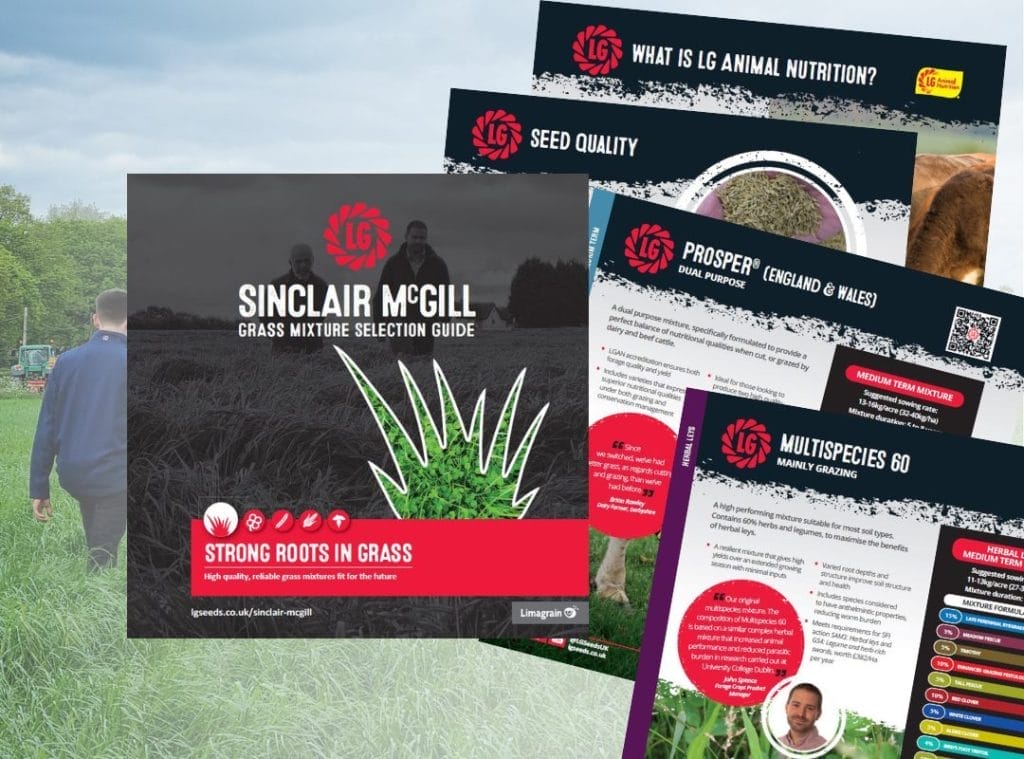United Kingdom
February 11, 2025
To maximise grassland productivity & sustainability, it’s crucial for farmers to recognise the most productive grass species. By understanding the strengths of different grasses, you can choose the right grass mixture to improve yields, enhance soil health, and boost animal performance.
Ryegrasses are the most commonly used species in LG Sinclair McGill grass mixtures but are often complemented with other grassland species, such as Timothy, Cocksfoot and fescues. These offer additional benefits to suit specific situations.
In this article, we’ll look at some of the key species for productive grassland; their uses, benefits, longevity and where they can be best used.
Perennial Ryegrasses (Lolium perenne)
This is the cornerstone species of UK grass seed mixtures due to its persistency, adaptability, longevity and high yield characteristics.
There are many perennial ryegrass varieties, usually subdivided into 3 groups categorised by the date at which they reach maturity. Early varieties typically produce a seed head in England and Wales in Mid-May, Intermediate varieties towards the end of May, and Late varieties in early June. In Scotland heading dates will on average be 2 weeks later due to the different climatic conditions.
Early Perennials
These varieties grow well and bulk up in early spring, making them ideal for early grazing and for conservation cutting.
Intermediate (Mid-Season) Perennials
A denser, more prostrate growth habit than early perennials, these varieties have a longer production season with high persistency and yield potential in grazing and cutting systems.
Mid-season perennials can be used to increase ground cover and forage quality in short-term mixtures and to boost yields in long-term mixtures.
Late Perennials
These varieties are extremely persistent and used in long-term mixtures, particularly those designed for intensive grazing. They offer excellent forage quality as they remain leafy and palatable for longer than other types, with good mid and late season growth and a good yield potential.
Italian Ryegrasses (Lolium multiflorum)

Italian ryegrass is the highest yielding of the ryegrass species lasting 18 to 24 months so is typically a mainstay short term conservation mixture. An excellent species to provide bulk but lower in forage quality than perennial ryegrasses. Their fast germination and establishment make them ideal for sowing as a catch crop.
Italian ryegrasses need frequent grazing or cutting to maintain their quality. They grow vigorously and respond well to nitrogen fertiliser but produce relatively few tillers so the sward can be fairly open. Surplus growth in autumn is best removed to promote winter hardiness.
Hybrid Ryegrasses (Lolium hybridum)
These carefully bred hybrids offer the benefits of both Perennial and Italian species. They are more persistent than Italian Ryegrass, lasting for between two and four years, and have higher yields than Perennial Ryegrass.
They will typically offer better ground cover than Italian ryegrasses increasing their suitability to grazing and are used successfully in mixtures with red clovers to make high-protein sward mixtures.
Tetraploid Ryegrasses
There are tetraploid varieties of both Italian and perennial ryegrasses. Tetraploids have a similar plant size but tend to have broader leaves, a more erect growth habit and deeper root systems compared with diploids. Tetraploids offer several advantages over the diploids, including:
- Increased palatability
- Higher sugars (Water soluble carbohydrates)
- Increased winter hardiness
- Increased tolerance to drought conditions
Timothy (Phleum pratense)
Timothy brings many advantages to grass seed mixtures and is often included in grazing and cutting mixtures for use in the north and west of the UK, where conditions can be colder and wetter.
Timothy grows at lower temperatures than ryegrasses which makes for excellent early Spring growth. It is very persistent and winter hardy, coping with wetter conditions and poorer soils. It will also continue to maintain palatability in mid-summer when other grasses may be past their peak production.
Timothy is a good variety choice in swards for grazing sheep.
Cocksfoot (Dactylis glomerata)
Cocksfoot has an extensive root system and is used in mixtures grown on lighter or drought prone soils. It has rapid regrowth and good summer production when other species may be affected by lack of moisture.
However, Cocksfoot is lower in digestibility and sugars than ryegrasses and it can easily become ‘tussocky’ and unpalatable for livestock if managed incorrectly.
Westerwolds (Lolium westerwoldicum)
These are annual grasses with vigorous growth giving very high yields. Their short life span of a single year, but rapid growth potential, means that Westerwold varieties are predominantly sown straight as a catch crop rather than being used in mixtures. They are well suited to bulk up silage production and zero grazing but need regular defoliation to prevent a fast decline in forage quality.
Creeping Red Fescue (Festuca rubra)
Winter hardy and early growing, on acidic soils and in wet and cold conditions, if necessary, makes red fescue an option in specific situations. It is used sparingly in grass seed mixtures.
Meadow Fescue (Festuca pratensis)
Meadow fescue is a nutritious leafy species and traditionally grown with Timothy in grass/clover swards. It is often included in mixtures designed for extensive grazing due to its good performance in low fertility or low input situations.
Putting it all together
LG Sinclair McGill mixtures have been developed through a combination of farm experience, variety and mixture trials as well as animal feeding trials. The current range builds on a foundation of over 50 years of farm success, with the latest research and technology, to produce the very best mixtures available.
Our mixtures are designed using the principles of sward mechanics. This means exploiting knowledge gained from scientific studies, showing the way different varieties and species interact when sown together, to formulate the best mix for each intended purpose.
We include varieties exclusive to LG Sinclair McGill, along with carefully selected varieties from other breeders that have proven performance in the UK Recommended Grass and Clover Lists, and our own variety trials.
To learn more, download the grass mixture selection guide here or contact your nearest seed supplier.

